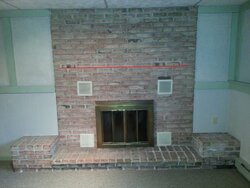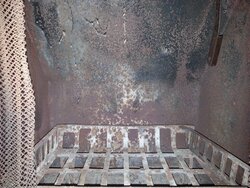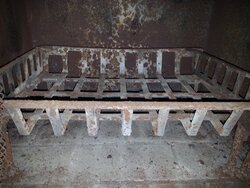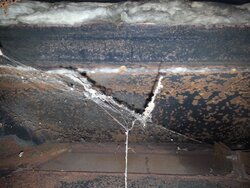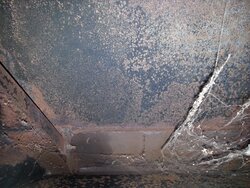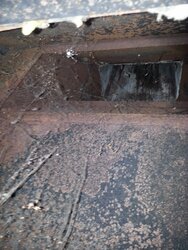Hi guys, been lurking these forums the last couple of days on help with my Heatform/Heatilator system. Looks like alot of knowledgeable guys in here so I figured I would ask my questions. I want to start remodeling my basement and want to take care of an issue now before it stings in the long run. I plan on tearing out the paneling and drywalling as well as using Natural Stone Veneer's to cover the old looking brick and finish with tile floors. I noticed my house has one of these metal box fireplaces. It appears to be in better condition than most but what I gather from experience of others, is that these are not recommended to be used anymore even if the condition isn't falling apart.
What do I do? My house is a bi-level and where I placed the red line is where the ground starts. So it's slightly below ground in the basement on this side of the house. I have a few questions I hope people can help me out with and alittle background I can provide. Currently I'm using electric heat (I know) and I have a free standing wood stove in a different room which I will start using next winter after inspection. I have central cool only air (only on the top floor of bi-level) in which I would move to a heat pump if/when the unit goes kapooey (11-12 years old). The free standing stove is located on the back of the bi-level (in a fairly large sunroom addition) with about 5 feet of steps going from this room to the room with the free standing stove (so the basement is connected to this room). I haven't burned yet but I'm assuming the freestanding fireplace will probably warm this room but I want flexibility with future homeowners or myself. I want to provide a future homeowner or myself the flexibility of doing something with the fireplace (or not) without destroying the basement all over again.
1. Do I have a mason blow the brick out and remove this hunk of metal?
2. Can it be cut out with a torch without dismantling all the brick?
3. What about the 4 vents? Since the fireplace probably cannot be used as is, should I mason these shut regardless?
4. Do I leave the fireplace as is because a gas insert/wood insert can be installed with the heatform still inside?
5. If a gas insert/wood insert can be installed with the heatform still in tact, can I still close these vents off when stoning?
Just looking for advice. Thanks guys.
What do I do? My house is a bi-level and where I placed the red line is where the ground starts. So it's slightly below ground in the basement on this side of the house. I have a few questions I hope people can help me out with and alittle background I can provide. Currently I'm using electric heat (I know) and I have a free standing wood stove in a different room which I will start using next winter after inspection. I have central cool only air (only on the top floor of bi-level) in which I would move to a heat pump if/when the unit goes kapooey (11-12 years old). The free standing stove is located on the back of the bi-level (in a fairly large sunroom addition) with about 5 feet of steps going from this room to the room with the free standing stove (so the basement is connected to this room). I haven't burned yet but I'm assuming the freestanding fireplace will probably warm this room but I want flexibility with future homeowners or myself. I want to provide a future homeowner or myself the flexibility of doing something with the fireplace (or not) without destroying the basement all over again.
1. Do I have a mason blow the brick out and remove this hunk of metal?
2. Can it be cut out with a torch without dismantling all the brick?
3. What about the 4 vents? Since the fireplace probably cannot be used as is, should I mason these shut regardless?
4. Do I leave the fireplace as is because a gas insert/wood insert can be installed with the heatform still inside?
5. If a gas insert/wood insert can be installed with the heatform still in tact, can I still close these vents off when stoning?
Just looking for advice. Thanks guys.


